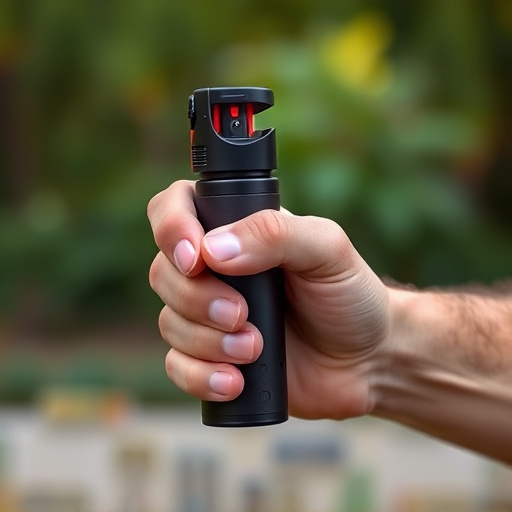Proper pepper spray decontamination steps at home are crucial for safety and resumption of daily routines after use. Evacuate, ventilate, remove contaminated clothing, wash affected areas, change into clean clothes, and regularly clean household surfaces to prevent buildup and cross-contamination. Implement an emergency kit with first-aid materials, flashlights, food, water, and pepper spray as a life-saving self-defense tool.
“In today’s unpredictable world, citizens are increasingly turning to defensive tools for personal safety. Pepper spray, a non-lethal self-defense mechanism, offers civilians an effective means of deterring potential threats. This comprehensive guide explores the multifaceted aspects of pepper spray use and decontamination steps at home. From understanding its properties to practical application and post-exposure measures, we equip readers with vital knowledge for enhancing their safety and security.”
- Understanding Pepper Spray: A Non-Lethal Self-Defense Tool
- Preparing Your Home for Emergency Situations: Step-by-Step Guide
- Effective Use and Safety Measures of Pepper Spray
- Post-Exposure Decontamination: Keeping Yourself and Your Space Safe
Understanding Pepper Spray: A Non-Lethal Self-Defense Tool
Pepper spray, a non-lethal self-defense tool, has become increasingly popular among civilians seeking protection against potential threats. Unlike firearms, pepper spray is designed to incapacitate an attacker temporarily, giving users time to escape or seek help. It works by irritating the eyes and respiratory system, causing the target to experience temporary blindness and severe coughing fits.
Understanding how to properly use and decontaminate pepper spray is crucial for ensuring its effectiveness in self-defense scenarios. After a confrontation, following specific decontamination steps at home is essential to minimize exposure to the irritants. This includes removing contaminated clothing, washing eyes and skin thoroughly with water, and cleaning shoes and other items that may have come into contact with the spray. Proper decontamination procedures help prevent secondary irritation and ensure users can safely return to their daily activities.
Preparing Your Home for Emergency Situations: Step-by-Step Guide
Preparing your home for emergency situations, especially those involving potential physical harm, is a proactive step in ensuring civilian protection. A key component of this preparation is implementing effective decontamination steps after any confrontation or exposure to hazardous substances. Start by creating an emergency kit that includes essential supplies like first-aid materials, flashlights, food, and water. Among these, pepper spray is a powerful tool for self-defense; its use should be accompanied by knowledge of proper decon procedures.
After any incident involving pepper spray or other irritants, follow these simple steps for home decontamination:
1. Evacuate the Area: Clear everyone from the room or area where the incident occurred to prevent further exposure.
2. Ventilate Thoroughly: Open windows and doors to allow fresh air circulation, dispersing any lingering spray or fumes.
3. Remove Contaminated Clothing: Take off any clothes that may have come into contact with the irritant, placing them in sealed plastic bags for later disposal.
4. Wash Affected Areas: Rinse eyes and skin thoroughly with clean water to dilute the pepper spray. Use mild soap if available but avoid irritating products.
5. Change into Clean Clothes: Put on fresh clothing after completing decontamination steps, ensuring no contaminated items remain on your person.
Effective Use and Safety Measures of Pepper Spray
Pepper spray, a powerful tool for personal defense, is designed to temporarily incapacitate an attacker by causing discomfort and disorientation. When used effectively, it can provide valuable time to escape or seek help. However, proper application and decontamination steps are crucial for safe use. After spraying an assailant, individuals should move to a safe distance, ideally several hundred feet away, allowing the pepper spray to take effect. This gives law enforcement time to respond, while also ensuring the user is not in close proximity to the irritants.
To ensure safety at home, decontamination steps are essential. Pepper spray can leave residue on clothing and skin, which may be transferred to other surfaces or remain active for extended periods. Users should immediately remove contaminated clothing and wash with warm, soapy water. High-pressure showers or washes designed for law enforcement decontamination are ideal for removing any remaining pepper spray particles. Regular cleaning of household surfaces with a solution of vinegar and water can help prevent long-term residue buildup. Remember, proper training in the use of pepper spray is vital to ensure its effective and safe deployment in potentially life-saving situations.
Post-Exposure Decontamination: Keeping Yourself and Your Space Safe
After encountering a potentially dangerous situation where pepper spray has been used, proper decontamination steps are crucial to ensure your safety and maintain a secure living environment. Start by removing any contaminated clothing or shoes immediately and placing them in sealed plastic bags for later disposal. Take a thorough shower, using soap and warm water to wash away any residual spray from your skin, hair, and eyes. Rinse all items that may have come into contact with the spray, such as bedding, furniture, or other textiles, with clean water.
To prevent re-exposure and ensure decontamination steps at home are effective, consider using specific cleaning solutions designed for pepper spray removal. These products can help break down and eliminate any remaining chemical residue on surfaces. Additionally, thoroughly clean and ventilate your living space to minimize the risk of cross-contaminations. Regularly launder bedding and replace air filters in your HVAC system to ensure a safe and secure environment after a pepper spray incident.
Pepper spray is a valuable addition to any civilian’s self-defense arsenal, offering a non-lethal way to deter and disable attackers. By understanding its properties, preparing your home with this tool, and following effective use and safety measures, including proper decontamination steps, you can enhance your protection. Armed with knowledge and the right tools, individuals can take proactive steps towards ensuring their safety in emergency situations while also learning crucial pepper spray decontamination steps at home.
